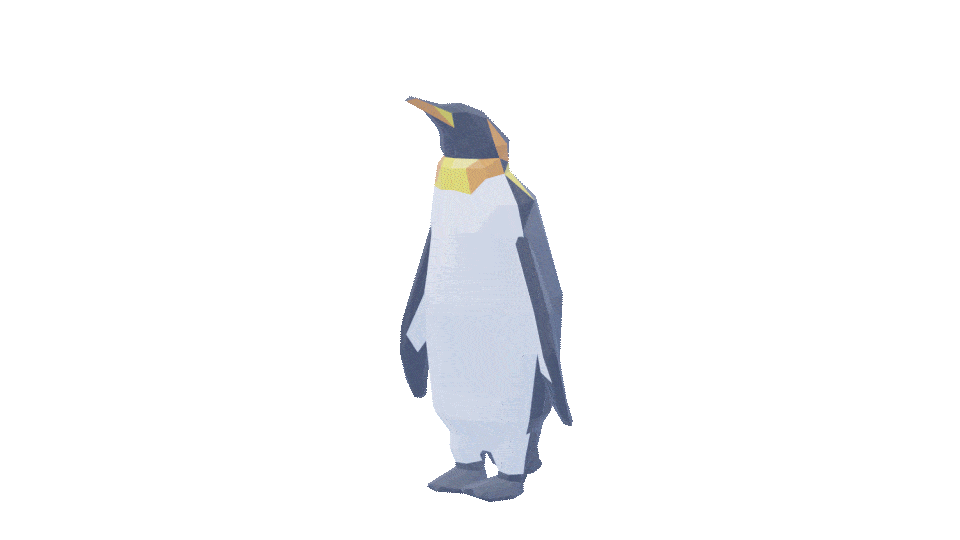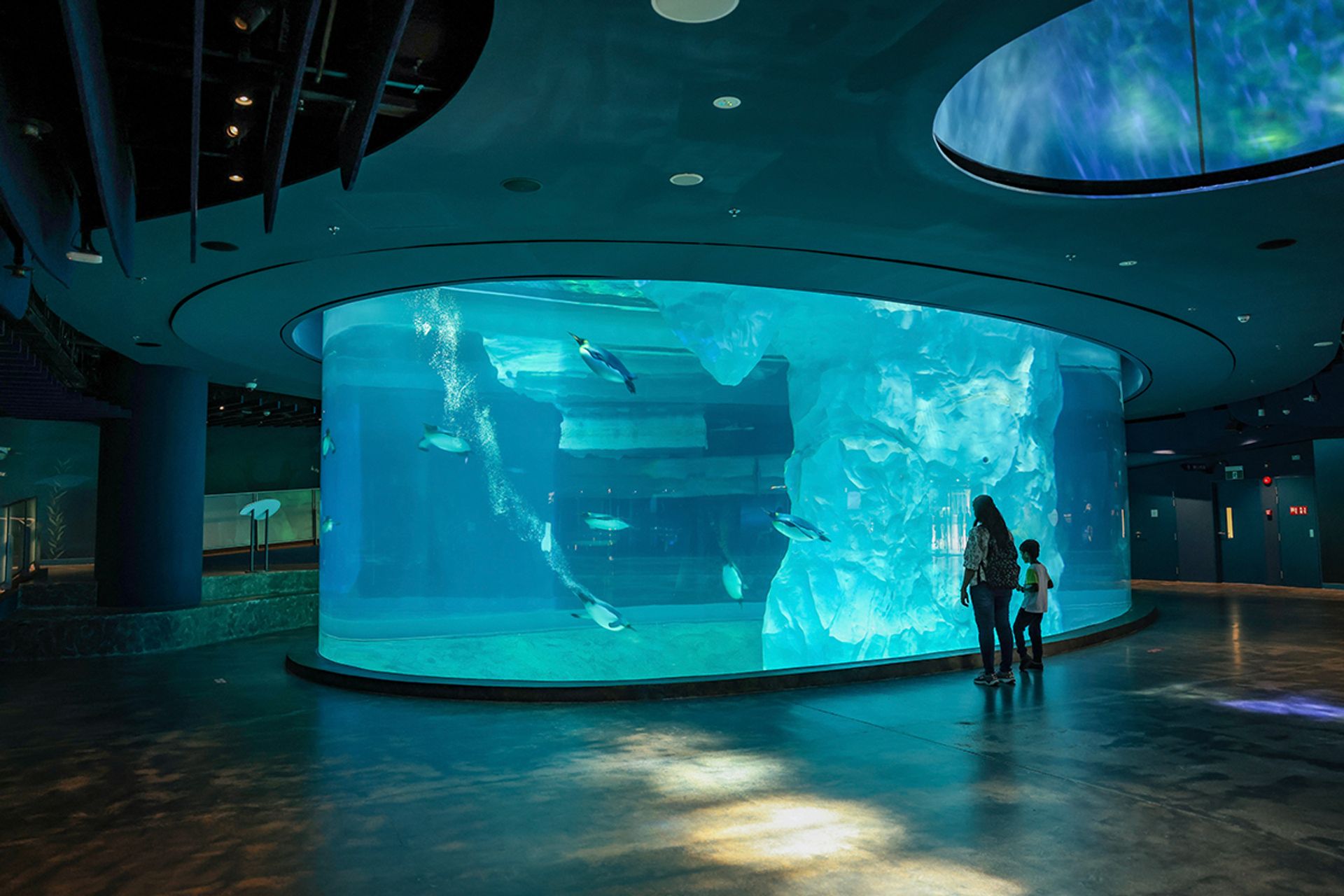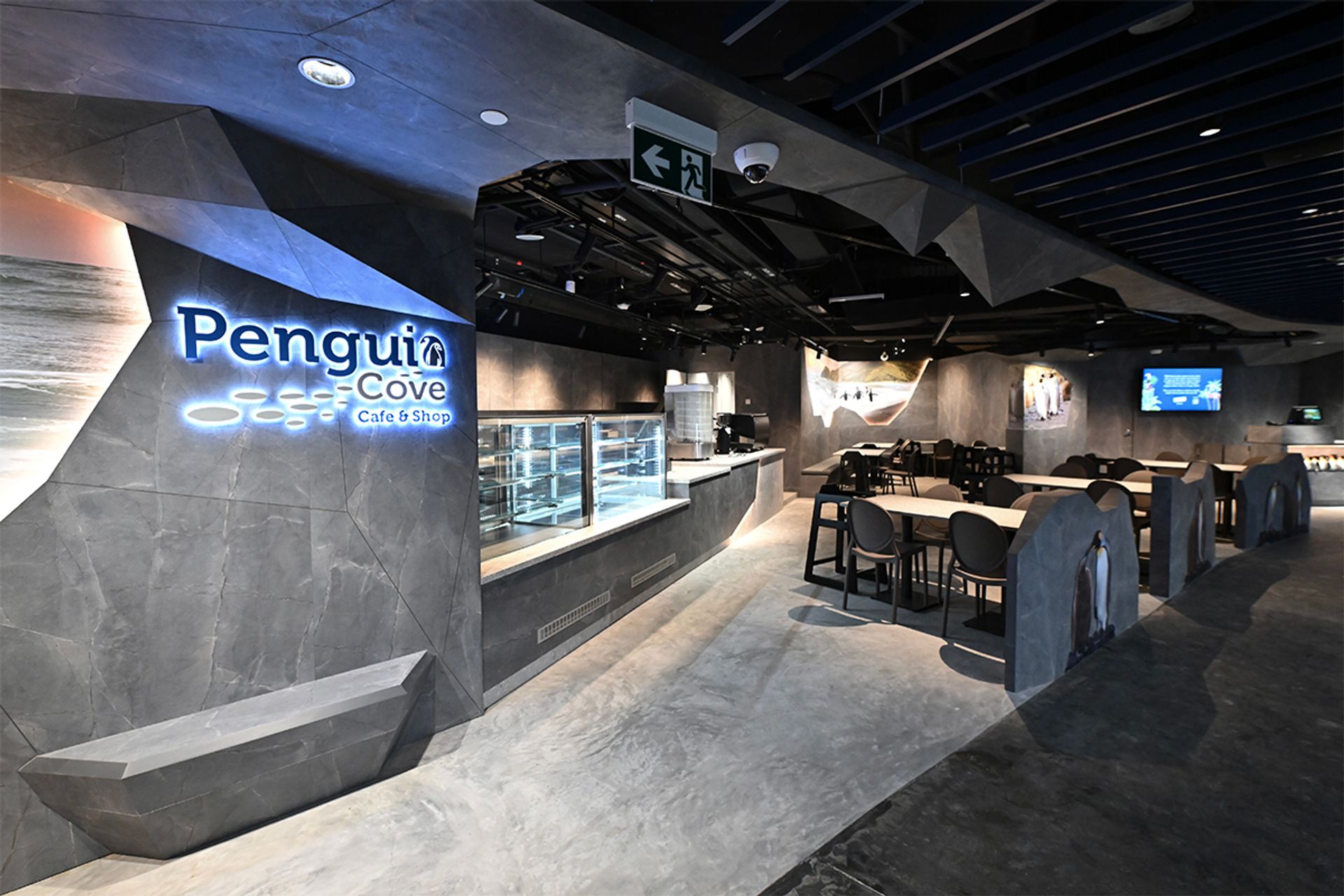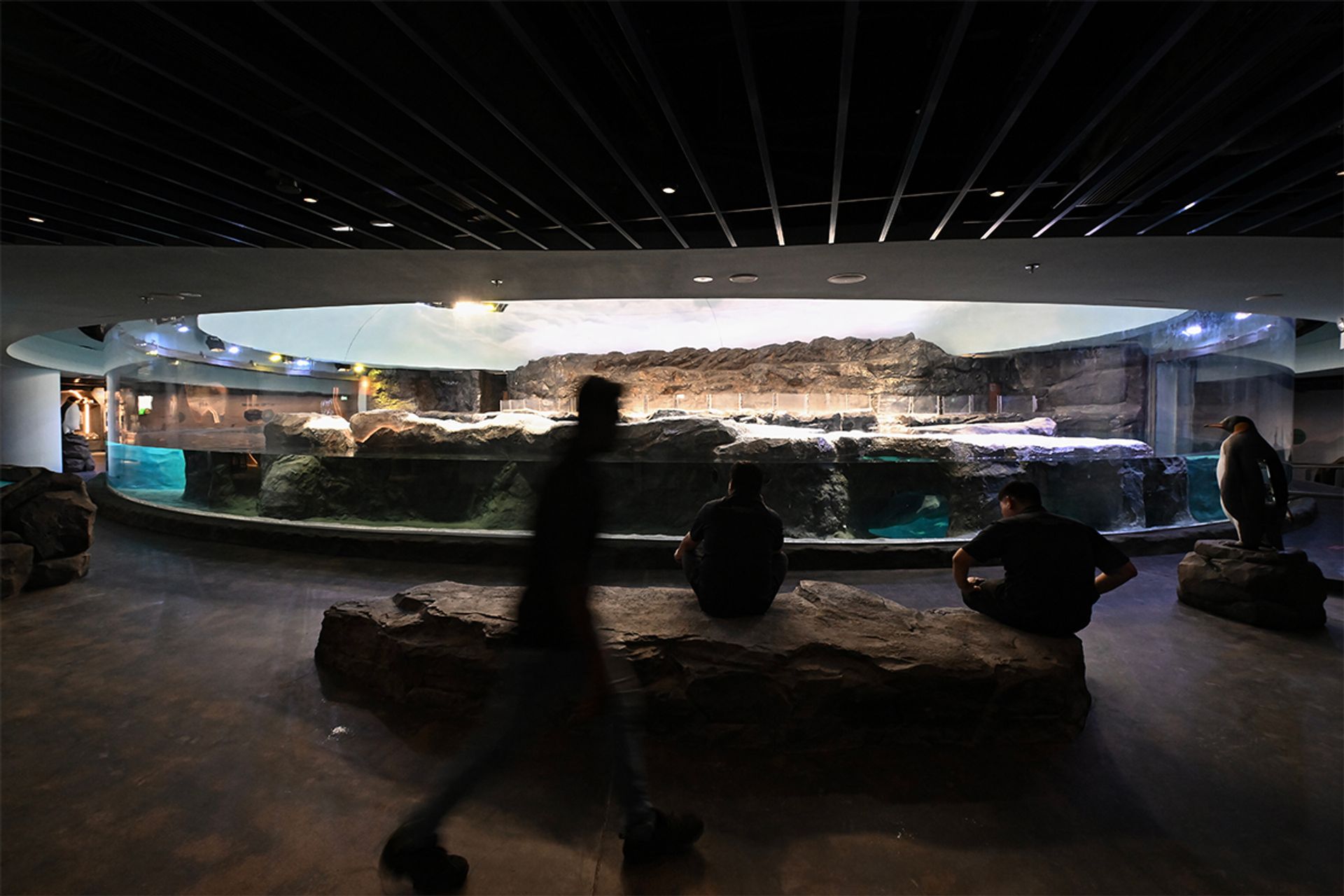On land, they waddle. Under water, they soar.
Here’s how Bird Paradise’s Penguin Cove was designed, to show penguins in all their glory – in and out of water.
In hot and sunny Singapore, a chilly exhibit for various penguin species has been built, tens of thousands of kilometres from their natural habitat.
Ocean Network Express Penguin Cove is designed for the varying needs of its 36 penguins across four species – like these rocky areas for agile gentoos and flatter terrains for taller kings, like Percy.
Percy may in future also use the flatter surface for breeding. But for now, the four-year-old male king penguin spends time exploring his new home.
Waddling towards the water, which is kept at a cool 9 deg C, and he dives head first into one of two 7m-deep diving tanks.
The two tanks, which are linked to each other, give the penguins two different experiences. One is occupied by an iceberg-like structure and the other a rocky one.
As he breaks the water’s surface, Percy lands on a platform with a gentle gradient that allows him to slide on his belly and push himself farther along.
Smaller species, like the gentoo, have also been provided optimal points to emerge from their swims as they prefer to propel themselves out of the water and land on their feet.
These design features help the exhibit achieve its main purpose – to showcase how the penguins would behave in the wild, as much as possible.
To encourage diving and hunting, for instance, the exhibit has a special device embedded in the rocky and iceberg structures in each of the two diving tanks.
Called a feeding chute, the device releases fish into the water for the penguins to “hunt” as a form of enrichment – they receive the bulk of their food from keepers on land.
Another feature is the exhibit's lighting, which is programmed to follow seasonal patterns in the Falkland Islands. Three of four penguin species in Bird Paradise are native to the remote archipelago in the South Atlantic.
The lighting changes mean the penguins are exposed to varying amounts of light over time, which triggers a moulting process that helps maintain their waterproofing.
Finally, a projection of the Southern Lights can be cast onto the exhibit’s ceiling – something guests will get to experience exclusively at Glamping With The Penguins, an overnight stay at Penguin Cove.
Dive deep into Penguin Cove’s key features
Perhaps the most noticeable difference between the penguin exhibits at Jurong Bird Park and Bird Paradise in Mandai – and one that the penguins themselves have experienced – is in the volume of water each exhibit can hold.
Penguin Cove has a much larger body of water than its predecessor. The 36 penguins from four species have much more space to swim, while visitors have more angles from which to observe the flightless birds as they soar – underwater.
“Penguins are unable to fly. But when they swim, they are so adept that it almost gives you the impression that they are flying underwater,” says Ms Rucha Khanderia, one of the architects from park operator Mandai Wildlife Group who worked on Penguin Cove.
“On land they are cute and waddling, but underwater you can really see their agility.”

One of the world’s largest penguin exhibit pools
Designed to showcase penguins’ natural behaviour, the exhibit’s large pool encourages the seabirds to spend more time in the water just as they would in the wild, especially during hunting season, says Mandai Wildlife Group vice-president for attractions development Marc Cremades.
At 1,100 cubic m – 10 times the volume of the pool in Jurong Bird Park’s penguin enclosure – Penguin Cove’s water body is one of the largest by volume for penguin displays in the world, he adds.

water
volume

Through an acrylic dome in the ceiling on the first storey, visitors can catch a rare view of the penguins from directly beneath them as they swim.

Recreating their natural habitat
On top of being roomier, the new exhibit has another upgrade to better simulate conditions in the penguins' natural habitat.
Instead of a freshwater habitat, as was the case in Jurong, it was decided that Penguin Cove would have a saltwater habitat.
Ms Anais Tritto, curator of birds at Mandai Wildlife Group, says salt water benefits the penguins’ eyes as it helps to lubricate them, and also is generally better for their health.
To prepare the penguins for the transition from fresh to salt water, the colony was fed salt tablets to reactivate their salt glands.
The glands, which filter excess salt out of the penguins’ bodies, ensures that their kidneys are not overworked.
Not long after salt tablets were added to their diets, the penguins started “sneezing” salt, says Ms Tritto. Penguins excrete excess salt through their nostrils, which is done when they shake their heads vigorously from side to side.
An upgraded lighting system also means that the penguins will soon get to sleep in complete darkness, as the new exhibit now comes with an infrared lighting mode.
When switched on, the infrared lights give keepers some visibility to continue maintaining the exhibit, but the penguins perceive themselves to be in complete darkness as there are certain wavelengths of light they cannot see.
In the absence of infrared lighting, the penguins have for years been sleeping under a dim light source – something the keepers are trying to wean them off.
Also not previously found in the Jurong exhibit are underwater shooters that eject capelins – which penguins eat on a daily basis – into the diving tanks.
Added as a form of enrichment for the birds, the shooters incentivise penguins to dive and hunt more – both of which are a big part of their lives, says Ms Tritto.
Scroll on to explore how the device works.
Step 1: Fishes are loaded into a canister.
Step 2: Fishes are launched using a pump.
Step 3: Fishes enter the tank.
Step 4: Penguins dive towards the fishes.
Features such as the fish chutes were inspired by studies of penguin exhibits around the world.
From an institution in the United States, for instance, Penguin Cove’s architects learnt more about lighting cycles, while early prototypes for the fish chute were picked up from an aquarium in Japan and then further developed. Exhibits in Europe and Hong Kong were also researched.

A burning question: How does Penguin Cove house penguins in Singapore’s tropical heat?
Besides differences in lighting capabilities and water salinity, the air and water temperatures in the Mandai exhibit are also significantly lower than the conditions in the old exhibit in Jurong.
The air temperature in Penguin Cove is now about 11 to 12 deg C, and will eventually be brought down to 9 deg C, compared with the 13 deg C previously in Jurong.
Similarly, the old exhibit’s water was chilled to about 15 deg C, while the new exhibit’s is kept at 9 deg C.
While still not as cool as the Falkland Islands, the temperatures at the exhibit were decided based on what could maximise animal welfare, as well as maintain prudent energy consumption, says Ms Tritto.
To ensure that the living conditions are optimal for the penguins, architect Tsai Chung Jay says designers had to study what the right mix of water and air chillers and filters would be, so that energy efficiency could be achieved while providing for the animals’ needs.
Such equipment is collectively called a life support system, and here’s how it works.
The life support system is a collection of filters and chillers for both air and water.
The air and water chillers keep the temperatures down.
Water is put through multiple filters and purified before being pumped back into the exhibit – ensuring that as little of it is wasted as possible.
Air passes through a series of four filter types to keep the penguins disease-free.
“We had to hit a balance between the performance of the system, and the cost of running it,” says Mr Tsai.
The exhibit building achieves overall energy savings of 30 per cent from a baseline reference chiller and filtration model, and minimises water wastage through a closed loop system, where water from the tanks is cleaned and pumped back into the exhibit.
Air-conditioning systems in the building also use magnetic bearings instead of lubricated ones, which help to bring energy consumption down.

Planning a visit to Bird Paradise? Here’s what to expect in Penguin Cove.
When entering Penguin Cove’s first storey from the park’s entrance plaza, visitors will first meet the penguins while they are underwater, in one of the two diving tanks.

On the same floor, in Penguin Cove Restaurant, guests can enjoy a seafood buffet while watching the penguins dive.
Taking a ramp up to the second storey brings visitors to the beach level, where they can enjoy a coffee or browse merchandise at the Penguin Cove Cafe and Shop while watching the penguins waddle on land.


To find out more about the penguins from those who work with them daily, guests can join in the Penguin Keeper Talk programme at 1.30pm every day. Keepers will speak about penguin behaviours and share anecdotes.
Bird Paradise is open daily from 9am to 6pm, with last admissions at 5pm.
Bookings for Glamping With The Penguins, which includes an overnight stay and three meals per person as well as programmes such as a behind-the-scenes tour to Bird Paradise’s Avian Hospital, can be made at Bird Paradise’s website.
Prices start from $1,699 per tent and each tent can hold four people. Participants have to be at least five years old.
